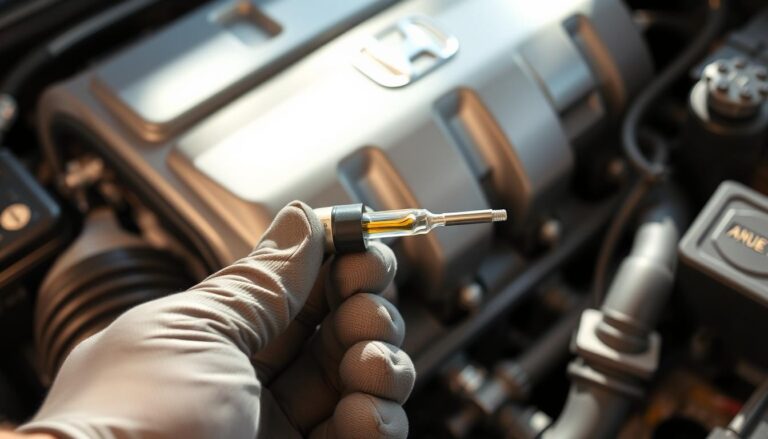Knowing exactly how many quarts of oil your Honda Civic takes is crucial for proper engine maintenance and longevity. Using too little oil can lead to inadequate lubrication and engine damage, while overfilling can cause foaming, reduced performance, and potential seal damage. This comprehensive guide covers oil capacity for all Honda Civic generations, recommended oil types, and practical maintenance advice to keep your vehicle running smoothly for years to come.
Honda Civic Oil Capacity Quick Reference Chart
For quick reference, here’s a breakdown of how many quarts of oil different Honda Civic models require. Always check your owner’s manual for the most accurate information specific to your vehicle.
| Generation | Years | Engine Type | Oil Capacity (with filter) | Recommended Oil |
| 11th Gen | 2022-2025 | 1.5L Turbo | 3.7 quarts (3.5 liters) | 0W-20 Synthetic |
| 11th Gen | 2022-2025 | 2.0L | 3.9 quarts (3.7 liters) | 0W-20 Synthetic |
| 11th Gen Type R | 2023-2025 | 2.0L Turbo | 5.4 quarts (5.1 liters) | 0W-20 Synthetic |
| 10th Gen | 2016-2021 | 1.5L Turbo | 3.7 quarts (3.5 liters) | 0W-20 Synthetic |
| 10th Gen | 2016-2021 | 2.0L | 3.9 quarts (3.7 liters) | 0W-20 Synthetic |
| 9th Gen | 2012-2015 | 1.8L | 3.9 quarts (3.7 liters) | 0W-20 Synthetic |
| 8th Gen | 2006-2011 | 1.8L | 3.9 quarts (3.7 liters) | 5W-20 |
| 7th Gen | 2001-2005 | 1.7L | 3.8 quarts (3.6 liters) | 5W-20 |
Honda Civic oil capacity reference chart by generation and engine type
Oil Capacity for Modern Honda Civics (10th & 11th Generation)
The latest Honda Civic generations (2016-present) feature more efficient engines with specific oil requirements. Let’s look at the exact oil capacity for these modern models:
11th Generation Honda Civic (2022-2025)
The 11th generation Civic continues Honda’s commitment to efficiency and performance with two main engine options:
- 1.5L Turbocharged Engine: Requires exactly 3.7 quarts (3.5 liters) of 0W-20 synthetic oil with filter change
- 2.0L Engine: Requires 3.9 quarts (3.7 liters) of 0W-20 synthetic oil with filter change
- Type R 2.0L Turbocharged Engine: Requires 5.4 quarts (5.1 liters) of 0W-20 synthetic oil with filter change
10th Generation Honda Civic (2016-2021)
The 10th generation introduced Honda’s turbocharged engines to the Civic lineup with these oil requirements:
- 1.5L Turbocharged Engine: 3.7 quarts (3.5 liters) with filter change
- 2.0L Engine: 3.9 quarts (3.7 liters) with filter change
- Type R 2.0L Turbocharged Engine: 5.4 quarts (5.1 liters) with filter change
- Hybrid 1.5L: 3.8 quarts (3.6 liters) with filter change
Get the Right Oil for Your Honda Civic
Using the manufacturer-recommended oil type and viscosity is crucial for your Civic’s performance and longevity. Honda recommends 0W-20 synthetic oil for most modern Civics.
Oil Capacity for Older Honda Civics (6th-9th Generation)
9th Generation Honda Civic (2012-2015)
The 9th generation Civic was the first to widely recommend 0W-20 oil across most of its lineup:
- 1.8L Engine: 3.9 quarts (3.7 liters) with filter change
- 2.4L Engine (Si models): 4.4 quarts (4.2 liters) with filter change
- Hybrid models: 3.3 quarts (3.1 liters) with filter change
8th Generation Honda Civic (2006-2011)
The 8th generation Civic was the last to widely use 5W-20 oil before Honda’s transition to 0W-20:
- 1.8L Engine: 3.9 quarts (3.7 liters) with filter change
- 2.0L Engine (Si models): 4.4 quarts (4.2 liters) with filter change
- Hybrid models: 3.3 quarts (3.1 liters) with filter change
7th Generation Honda Civic (2001-2005)
- 1.7L Engine (DX, LX, EX): 3.8 quarts (3.6 liters) with filter change
- 1.7L Engine (HX, GX, hybrid): 3.7 quarts (3.5 liters) with filter change
- 2.0L Engine (Si models): 4.2 quarts (4.0 liters) with filter change
6th Generation Honda Civic (1996-2000)
- 1.6L Engine (all trims): 3.7 quarts (3.5 liters) with filter change
- 1.6L VTEC Engine (Si, GX models): 3.9 quarts (3.7 liters) with filter change
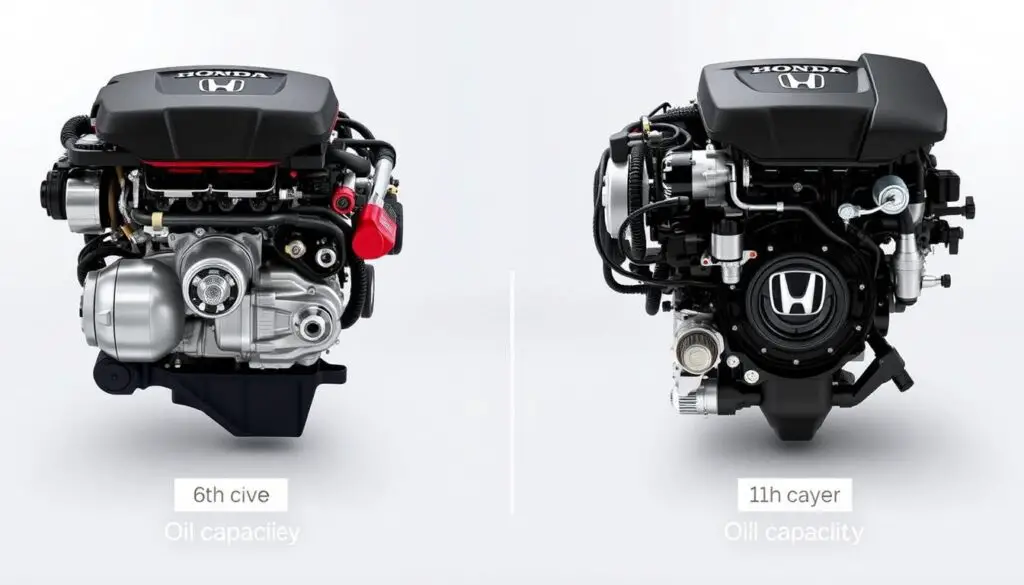
Evolution of Honda Civic engines across generations with different oil requirements
Recommended Oil Types for Honda Civic
Using the correct oil type is just as important as using the right amount. Honda has specific recommendations for each Civic model year:
| Generation | Years | Recommended Oil Type | Alternative (if needed) |
| 11th & 10th Gen | 2016-present | 0W-20 Synthetic | None recommended |
| 9th Gen | 2012-2015 | 0W-20 Synthetic | 5W-20 (emergency only) |
| 8th Gen | 2006-2011 | 5W-20 | 0W-20 (acceptable) |
| 7th Gen | 2001-2005 | 5W-20 | 5W-30 (acceptable) |
| 6th Gen | 1996-2000 | 5W-30 | 10W-30 (hot climates) |
Synthetic vs. Conventional Oil for Honda Civic
While earlier Honda Civic models were designed for conventional oil, most Civics produced after 2010 benefit significantly from synthetic oil:
Synthetic Oil Benefits:
- Better performance in extreme temperatures
- Enhanced engine protection and cleanliness
- Extended oil change intervals (7,500-10,000 miles)
- Improved fuel economy (2-3% on average)
- Superior protection for turbocharged engines
Conventional Oil Considerations:
- More economical for older Civics (pre-2010)
- Requires more frequent changes (3,000-5,000 miles)
- Less thermal stability in severe conditions
- Adequate for non-turbocharged older models
- More readily available in some areas
Upgrade to Premium Synthetic Oil
For optimal engine protection and extended change intervals, consider upgrading to a premium synthetic oil specifically formulated for Japanese engines.
Step-by-Step Honda Civic Oil Change Guide
Changing your Honda Civic’s oil is a straightforward process that can save you money and ensure the job is done correctly. Here’s a detailed guide to help you complete this essential maintenance task.
Tools and Materials Needed
Required Parts:
- Correct amount of oil for your specific Honda Civic model
- Oil filter (Honda Genuine recommended)
- Drain plug washer (14mm for most models)
Required Tools:
- Oil filter wrench
- Drain pan (minimum 5-quart capacity)
- Funnel
- 17mm socket wrench (for drain plug)
- Jack and jack stands or ramps
- Gloves and shop rags
Oil Change Procedure
- Preparation: Warm the engine for about 5 minutes. Park on a level surface, engage the parking brake, and place wheel chocks behind the rear wheels. Raise the front of the vehicle using a jack and secure with jack stands, or drive onto ramps.
- Remove the splash shield: Use a Phillips screwdriver and flathead screwdriver to remove the splash shield screws. The exact number and type of screws may vary by model year.
- Drain the old oil: Position your drain pan under the oil drain plug. Use a 17mm socket to loosen the drain plug counterclockwise. Once loose, remove by hand (carefully, as the oil may be hot) and allow the oil to drain completely (5-10 minutes).
- Replace the oil filter: Position the drain pan under the oil filter. Use an oil filter wrench to loosen the old filter by turning counterclockwise. Remove the old filter by hand and allow any remaining oil to drain. Apply a thin film of new oil to the gasket of the new filter and install hand-tight.
- Replace the drain plug: Clean the drain plug and install a new crush washer. Reinstall the drain plug and tighten to 30 ft-lbs (40 N⋅m) using a torque wrench if available.
- Add new oil: Lower the vehicle if raised. Remove the oil filler cap on top of the engine. Using a funnel, add the specified amount of oil for your Honda Civic model (refer to our table above).
- Check oil level: Replace the oil filler cap. Start the engine and let it run for about a minute. Shut off the engine and wait 5 minutes for the oil to settle. Check the oil level using the dipstick, ensuring it’s between the minimum and maximum marks.
- Reinstall the splash shield: Replace the splash shield and secure with all screws.
- Reset the maintenance minder: For most modern Civics, navigate to the “Vehicle Settings” menu on your infotainment system, select “Maintenance Info,” then “Reset Selected Items.”

Visual step-by-step guide for Honda Civic oil change procedure
Get Professional-Grade Oil Change Tools
Make your DIY oil changes easier and more efficient with professional-grade tools specifically designed for Honda vehicles.
Honda Civic Oil Change Maintenance Schedule
Following the recommended oil change intervals is crucial for maintaining your Honda Civic’s engine performance and longevity. Modern Honda Civics are equipped with the Maintenance Minder system, which calculates the optimal oil change interval based on your actual driving conditions.
Maintenance Minder System
When your Civic needs an oil change, you’ll see:
- Code “A” on the information display
- The wrench icon illuminated
- Percentage of oil life remaining (when it approaches 15%, start planning for an oil change)
Traditional Mileage Guidelines
If your Honda Civic doesn’t have the Maintenance Minder system or you prefer traditional intervals:
| Oil Type | Normal Conditions | Severe Conditions* |
| Conventional oil | Every 3,000-5,000 miles (4,800-8,000 km) | Every 3,000 miles (4,800 km) |
| Synthetic oil | Every 7,500-10,000 miles (12,000-16,000 km) | Every 5,000-7,500 miles (8,000-12,000 km) |
*Severe conditions include frequent short trips (less than 10 miles), extreme temperatures, stop-and-go traffic, towing, or driving on dusty roads.
Signs Your Honda Civic Needs an Oil Change
While following the recommended oil change intervals is important, it’s equally vital to recognize the signs that your Honda Civic might need an oil change sooner:
Oil Appearance Warning Signs
Check your dipstick regularly. Fresh oil is amber and translucent. Warning signs include:
- Dark brown or black oil (extreme opacity)
- Gritty texture or visible particles
- Milky or foamy appearance (could indicate coolant contamination)
- Oil level below the minimum mark on the dipstick
Engine Performance Warning Signs
- Increased engine noise, particularly ticking or knocking
- Rougher idle than normal
- Decreased power or acceleration
- Reduced fuel economy
- Oil pressure warning light illuminated
- Check engine light activated
Frequently Asked Questions About Honda Civic Oil Capacity
Can I use 5W-30 instead of 0W-20 in my Honda Civic?
While 5W-30 can work in emergency situations, it’s not recommended for regular use in modern Civics designed for 0W-20. Using a higher viscosity oil like 5W-30 in an engine designed for 0W-20 can reduce fuel economy by up to 2-3% and potentially void your warranty if engine damage occurs.
The ‘0W’ in 0W-20 indicates better cold flow properties than 5W-30, which is critical for reducing engine wear during cold starts. Additionally, the higher ’30’ viscosity when hot creates more internal friction than the recommended ’20’ rating, working against the engine’s design parameters.
What happens if I put too much oil in my Honda Civic?
Overfilling your Honda Civic’s engine with oil can cause serious problems. As little as 0.5 quarts of excess oil can lead to:
- Oil foaming: The crankshaft can whip air into the excess oil, creating foam that provides poor lubrication
- Increased crankcase pressure: Can blow out seals and gaskets, leading to leaks
- Catalytic converter damage: Oil may be forced past the piston rings and into the combustion chamber
- Reduced performance: The crankshaft must work harder to move through excess oil
If you suspect you’ve overfilled your Civic, check the dipstick. If the oil level is above the maximum mark, have some oil professionally drained to the correct level.
Is synthetic oil worth the extra cost for my Honda Civic?
For most Honda Civic owners, especially those with 2010 and newer models, synthetic oil provides value that justifies its higher cost. When considering the extended change intervals, synthetic oil typically costs just
Frequently Asked Questions About Honda Civic Oil Capacity
Can I use 5W-30 instead of 0W-20 in my Honda Civic?
While 5W-30 can work in emergency situations, it’s not recommended for regular use in modern Civics designed for 0W-20. Using a higher viscosity oil like 5W-30 in an engine designed for 0W-20 can reduce fuel economy by up to 2-3% and potentially void your warranty if engine damage occurs.
The ‘0W’ in 0W-20 indicates better cold flow properties than 5W-30, which is critical for reducing engine wear during cold starts. Additionally, the higher ’30’ viscosity when hot creates more internal friction than the recommended ’20’ rating, working against the engine’s design parameters.
What happens if I put too much oil in my Honda Civic?
Overfilling your Honda Civic’s engine with oil can cause serious problems. As little as 0.5 quarts of excess oil can lead to:
- Oil foaming: The crankshaft can whip air into the excess oil, creating foam that provides poor lubrication
- Increased crankcase pressure: Can blow out seals and gaskets, leading to leaks
- Catalytic converter damage: Oil may be forced past the piston rings and into the combustion chamber
- Reduced performance: The crankshaft must work harder to move through excess oil
If you suspect you’ve overfilled your Civic, check the dipstick. If the oil level is above the maximum mark, have some oil professionally drained to the correct level.
Is synthetic oil worth the extra cost for my Honda Civic?
For most Honda Civic owners, especially those with 2010 and newer models, synthetic oil provides value that justifies its higher cost. When considering the extended change intervals, synthetic oil typically costs just $0.002 more per mile driven while providing significantly better protection.
The benefits are most pronounced for:
- Turbocharged models (all 1.5L and 2.0L turbo engines)
- Vehicles driven in extreme temperatures
- High-mileage Civics (over 75,000 miles)
- Vehicles with direct injection systems (most 2012+ models)
Honda specifically engineers modern Civics with synthetic oil in mind, optimizing clearances and oil passages for its properties.
Does the Honda Civic Hybrid take the same amount of oil as the standard models?
Honda Civic Hybrid models typically require slightly different oil quantities compared to their conventional counterparts:
- 10th Generation Hybrid (2019-2021): 3.8 quarts (3.6 liters) with filter change
- 9th Generation Hybrid (2012-2015): 3.3 quarts (3.1 liters) with filter change
- 8th Generation Hybrid (2006-2011): 3.3 quarts (3.1 liters) with filter change
Hybrid models also have specific oil requirements beyond just the quantity. They require oils meeting Honda’s HTO-06 specification to ensure compatibility with the hybrid system’s unique operating conditions.
Why is my Honda Civic burning oil, and does it affect how much I should add during changes?
Some oil consumption is normal in all engines, including Honda Civics. According to Honda’s technical standards, consumption up to 1 quart per 1,200 miles is considered within acceptable limits for engines with more than 50,000 miles.
Common causes of increased oil consumption in Honda Civics include:
- Normal piston ring wear (more common in higher-mileage vehicles)
- PCV valve issues (a common issue in 8th generation models)
- Valve seal deterioration (more prevalent in vehicles over 100,000 miles)
- Oil quality and viscosity (using incorrect oil specifications can increase consumption)
If your Civic is consuming oil, you should check the oil level every 1,000 miles and top up as needed to maintain the correct level. Still perform complete oil changes at the recommended intervals, and consider having the engine evaluated if consumption exceeds 1 quart per 1,000 miles.
.002 more per mile driven while providing significantly better protection.
The benefits are most pronounced for:
- Turbocharged models (all 1.5L and 2.0L turbo engines)
- Vehicles driven in extreme temperatures
- High-mileage Civics (over 75,000 miles)
- Vehicles with direct injection systems (most 2012+ models)
Honda specifically engineers modern Civics with synthetic oil in mind, optimizing clearances and oil passages for its properties.
Does the Honda Civic Hybrid take the same amount of oil as the standard models?
Honda Civic Hybrid models typically require slightly different oil quantities compared to their conventional counterparts:
- 10th Generation Hybrid (2019-2021): 3.8 quarts (3.6 liters) with filter change
- 9th Generation Hybrid (2012-2015): 3.3 quarts (3.1 liters) with filter change
- 8th Generation Hybrid (2006-2011): 3.3 quarts (3.1 liters) with filter change
Hybrid models also have specific oil requirements beyond just the quantity. They require oils meeting Honda’s HTO-06 specification to ensure compatibility with the hybrid system’s unique operating conditions.
Why is my Honda Civic burning oil, and does it affect how much I should add during changes?
Some oil consumption is normal in all engines, including Honda Civics. According to Honda’s technical standards, consumption up to 1 quart per 1,200 miles is considered within acceptable limits for engines with more than 50,000 miles.
Common causes of increased oil consumption in Honda Civics include:
- Normal piston ring wear (more common in higher-mileage vehicles)
- PCV valve issues (a common issue in 8th generation models)
- Valve seal deterioration (more prevalent in vehicles over 100,000 miles)
- Oil quality and viscosity (using incorrect oil specifications can increase consumption)
If your Civic is consuming oil, you should check the oil level every 1,000 miles and top up as needed to maintain the correct level. Still perform complete oil changes at the recommended intervals, and consider having the engine evaluated if consumption exceeds 1 quart per 1,000 miles.
Recommended Oil Change Products for Honda Civic
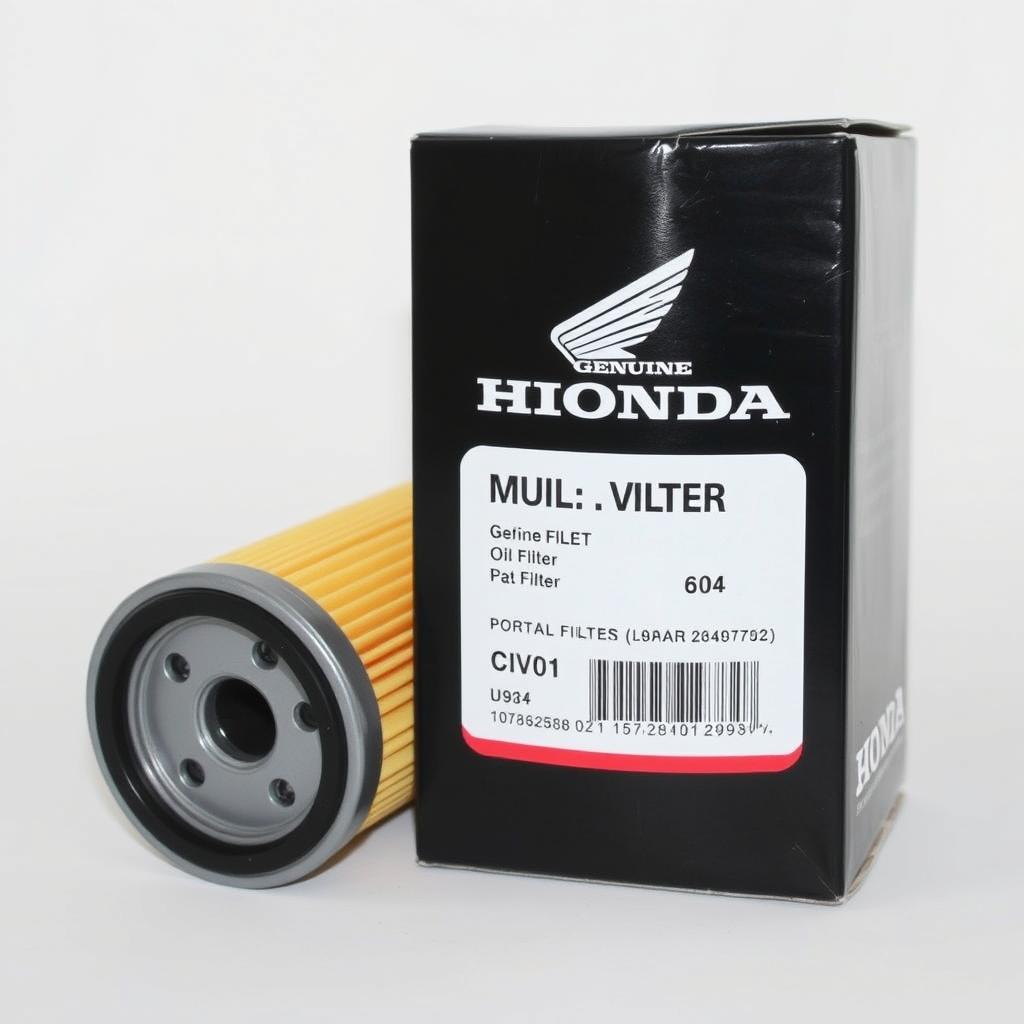
Honda Genuine Oil Filter
Designed specifically for Honda engines, these filters provide optimal filtration and proper fit. Compatible with all Honda Civic models.
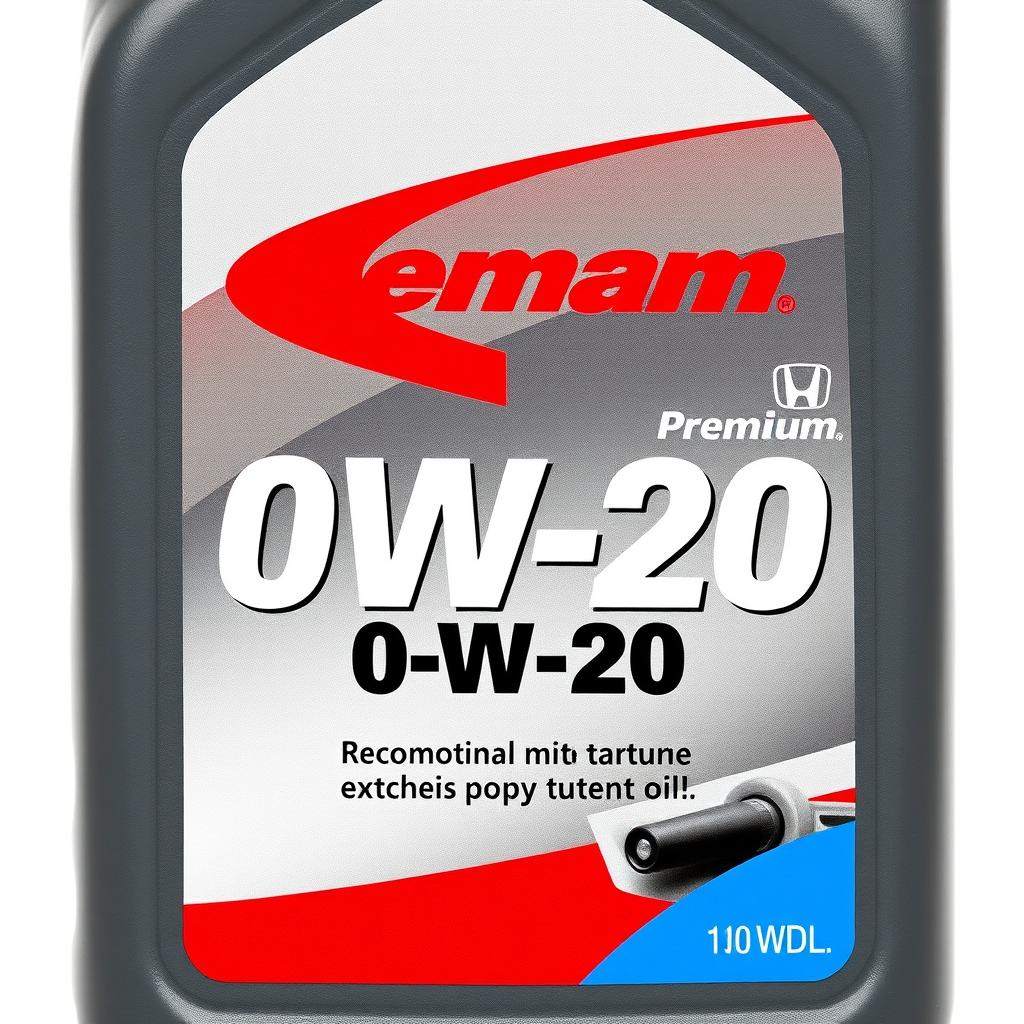
Premium 0W-20 Synthetic Oil
Full synthetic oil formulated for modern Honda engines. Provides superior protection for both turbocharged and naturally aspirated Civic engines.
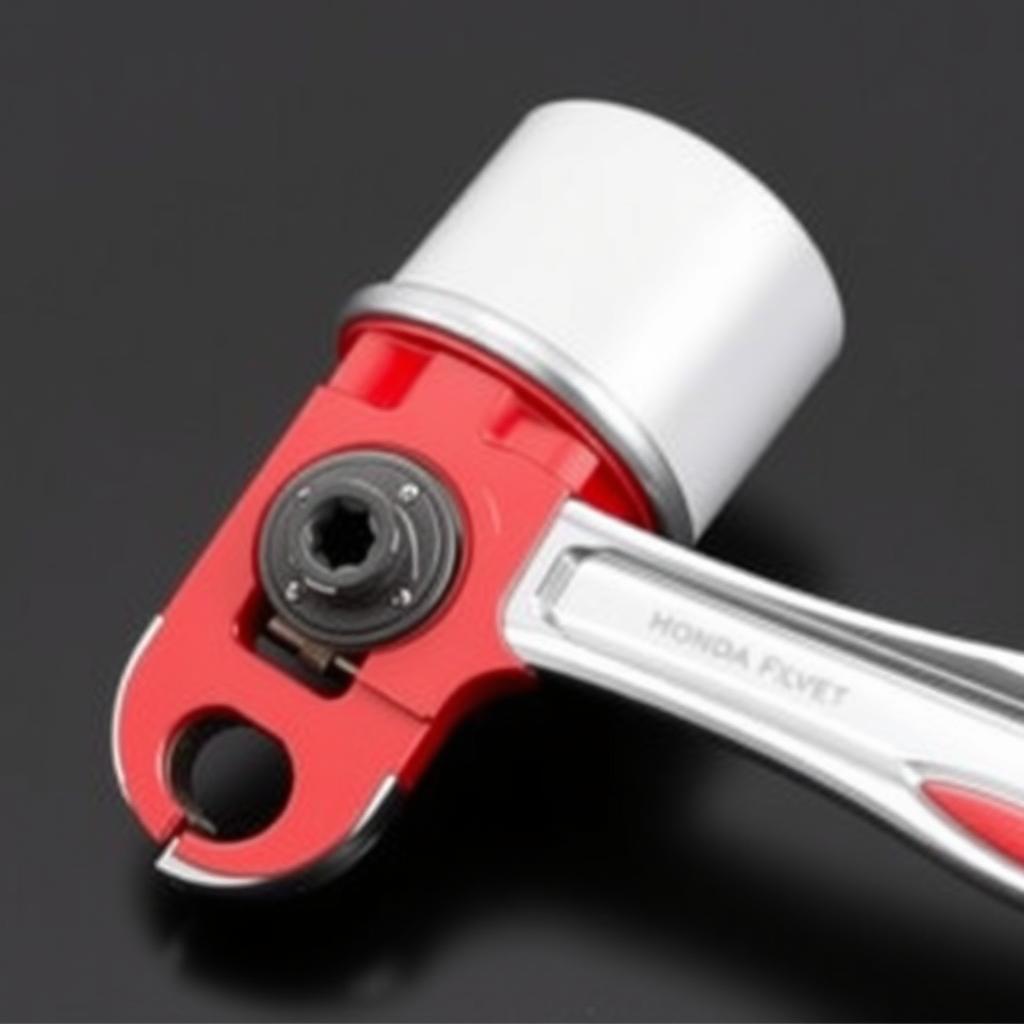
Honda Oil Filter Wrench
Specially designed tool for removing Honda oil filters without damaging them. Makes oil changes faster and easier.

Conclusion: Maintaining Your Honda Civic’s Oil
Understanding how many quarts of oil your Honda Civic takes is essential for proper maintenance and engine longevity. As we’ve explored in this comprehensive guide, the oil capacity varies across different Honda Civic generations and engine types, ranging from 3.3 quarts in some hybrid models to 5.4 quarts in the high-performance Type R variants.
Remember these key points about your Honda Civic’s oil capacity:
- Most modern Honda Civics (2016-2025) require between 3.7 to 4.5 quarts depending on engine type
- Always refer to your specific model’s requirements rather than general guidelines
- Account for whether you’re changing the oil filter (which typically adds 0.2-0.3 quarts to the capacity)
- Use the exact amount specified—neither too much nor too little
- Follow Honda’s recommendations for oil type and viscosity
- Pay attention to your Maintenance Minder system or follow recommended change intervals
By following these guidelines and maintaining proper oil levels in your Honda Civic, you’re making one of the most cost-effective investments in your vehicle’s health and performance. Regular oil changes with the correct amount and type of oil will help ensure your Civic remains reliable for many miles to come.
Disclaimer: While we’ve made every effort to ensure the accuracy of this information, always consult your Honda Civic’s owner’s manual for the specific oil capacity and type recommended for your exact model, year, and engine. When in doubt, consult with a certified Honda technician.
Keep Your Honda Civic Running Smoothly
Regular oil changes with the correct oil capacity and type are essential for your Honda Civic’s longevity. Get all the supplies you need for your next oil change today.
